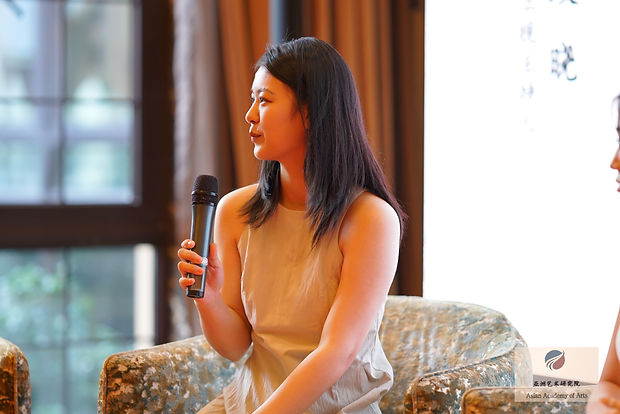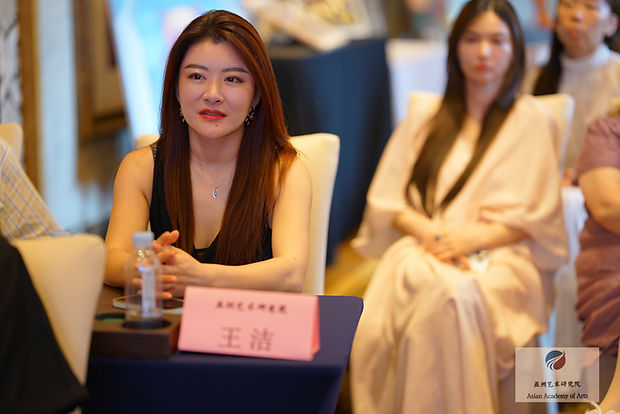Our
Forum
Location: Shanghai, China
Date: July 28, 2024
Participants: 60
Topics: New generation artists and curators share
Shanghai | Forum Recap: New Generation Artists and Curators Share
Exploring and Expressing Emerging Asian Art
On the afternoon of July 28, 2024, the second forum of the Asian Summer of Art series was held in Shanghai. Organized by the Asian Academy of Arts, the session brought together young artists and curators to discuss how the emerging generation is expressing itself, navigating challenges, and building a future in the global art landscape.

The forum featured four guest speakers:
-
Chunyao Guo – Emerging painter, postgraduate at China Academy of Art
-
Zixuan Zhuang – Curator specializing in immersive digital art, based in New York
-
Shuhao Liu – Multidisciplinary artist, Shanghai-based
-
Xinyi Du – Artist, curator, and advisor, PhD candidate in Art History at the Autonomous University of Barcelona
Part 1: Support and Expectations
Moderator: “What kind of support do you most hope for at this stage of your career? What does participating in today’s event mean to you?”
Chunyao Guo
“As a painter currently transitioning out of academia, I'm still finding my way in the art world. What I truly need are opportunities to show my work. Through exhibitions, I can receive feedback from different communities, which helps me understand myself and evolve.”
Zixuan Zhuang
“As a curator based in New York, my work focuses on immersive, multimedia-based exhibitions. I want to bridge traditional and contemporary, physical and digital. Platforms like the Asian Academy of Arts give us space to think globally while anchoring in cultural roots. I hope to continue introducing Asian emerging artists to new audiences through more technologically integrated curatorial formats.”
Shuhao Liu
“I'm honored to speak here today. I believe what young artists need most is sustained visibility and long-term collaboration with professional institutions. We want to not only have our works collected, but to also bring emotional resonance to viewers. I envision a model of collaboration that is multidimensional—online and offline, artistic and market-oriented, meaningful for both creators and audiences.”
Xinyi Du
“I’m truly grateful for this platform. Having senior figures listen attentively to our voices means a lot. My work focuses on female identity and personal narratives. I aim to express both strength and subtlety. Being included in the Asian Emerging Artist List is a validation, but also a responsibility.”


Part 2: Navigating Global and Local
Moderator: “How do you reconcile international exposure with local cultural identity in your work?”
Zixuan Zhuang
“When I applied to Columbia, I wrote that I wanted to be a cultural bridge between East and West. I curate from a position of hybridity. Whether it's ink-based projection work or immersive exhibition design, I want to show the poetic logic of Chinese art in new global formats.”
Shuhao Liu
“Young artists today must be fluent in both local language and global thinking. I don't just want short-term exposure—I seek long-term partnerships. We need structures that support creative development, not just output. That means working closely with institutions and curators who understand both context and commitment.”


Part 3: On Facing Creative Bottlenecks
Moderator: “Have you experienced creative bottlenecks, and how do you deal with them?”
Chunyao Guo
“For me, hitting a wall often sparks energy. I like to read philosophy and classic texts—Taoism, Buddhism, the I Ching—not from a religious standpoint, but to find connections between inner growth and creative evolution.”
Zixuan Zhuang
“On the technical side, I study immersive exhibitions globally and collaborate with tech teams to bring ideas to life. The academic side is still developing for me—but I find learning through international case studies and experimenting with visual language rewarding.”
Shuhao Liu
“Physical health is essential for creativity. When I’m stuck, I exercise—cycling, basketball, whatever gets me back in rhythm. I also believe artists must accept that bottlenecks are part of the process. What matters is maintaining a long view.”
Xinyi Du
“For many of us trained in fine arts, the biggest challenge comes after school—when you realize no one tells you what to do next. The emotional and economic gap between artistic intention and market reality is wide. As artists, we must learn to read the room—not just create from within, but also place ourselves realistically in the art ecosystem.”


Closing Words
The forum concluded with gratitude to all participants and a note of optimism.
While challenges remain, the insights and commitments shared pointed toward a future in which emerging Asian voices will not only be recognized but will actively shape the cultural agenda.
Guests were then invited to continue their conversations over tea at the closing reception.


